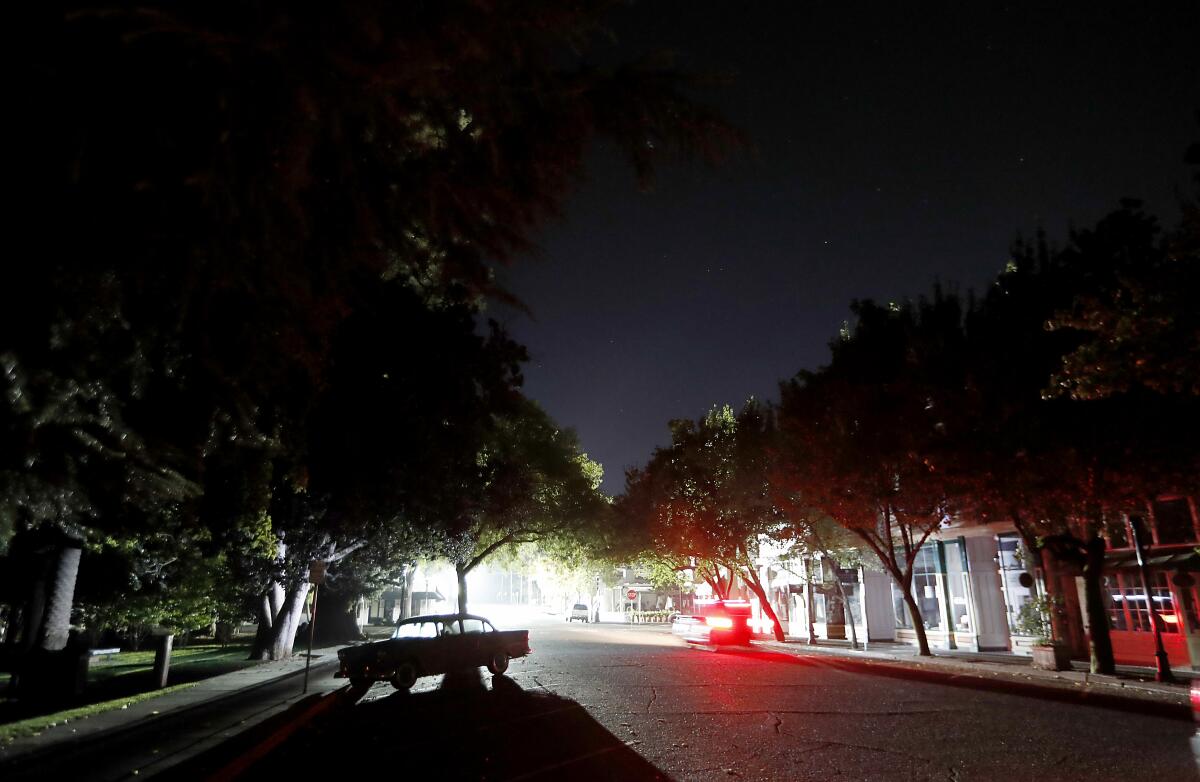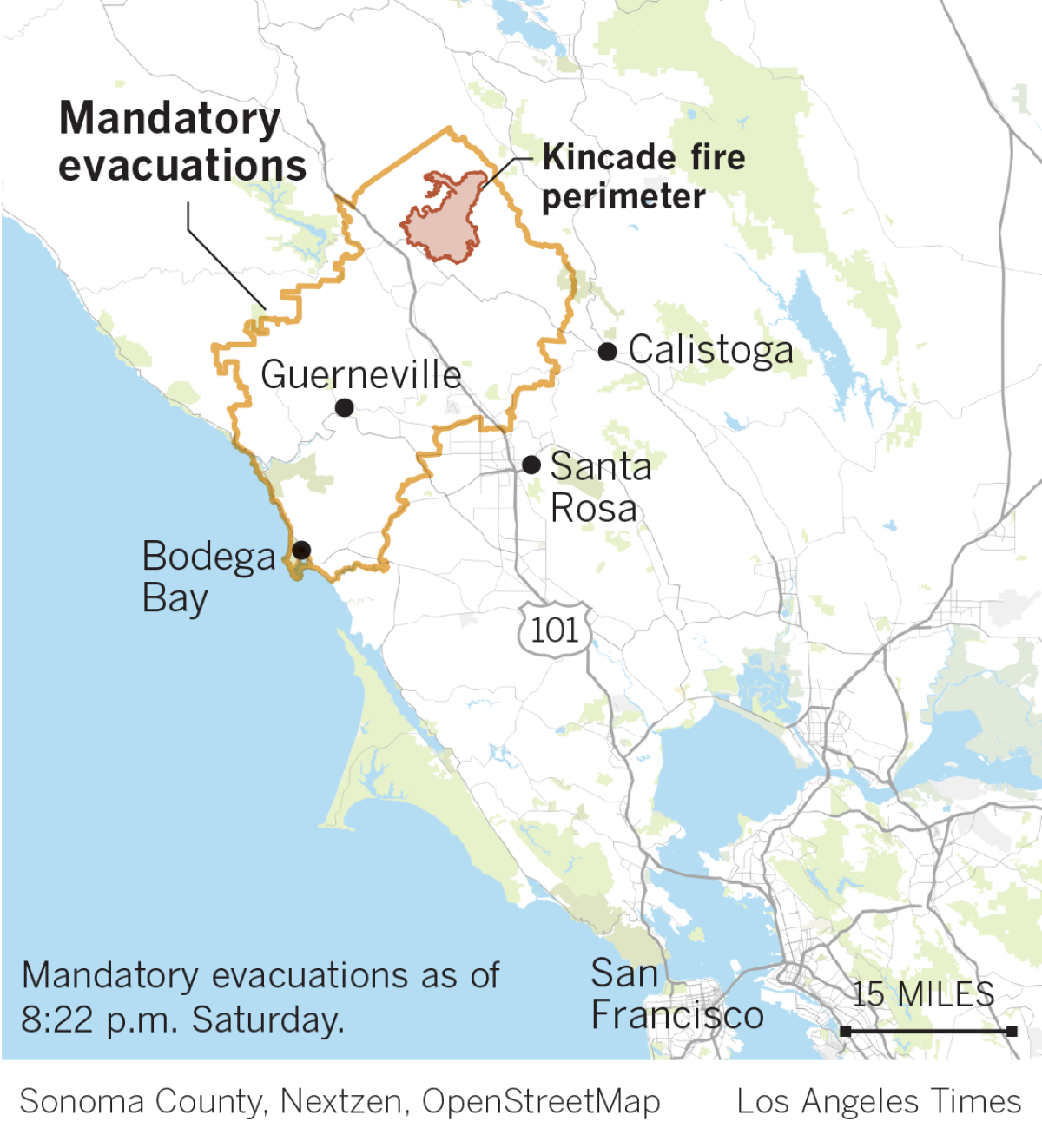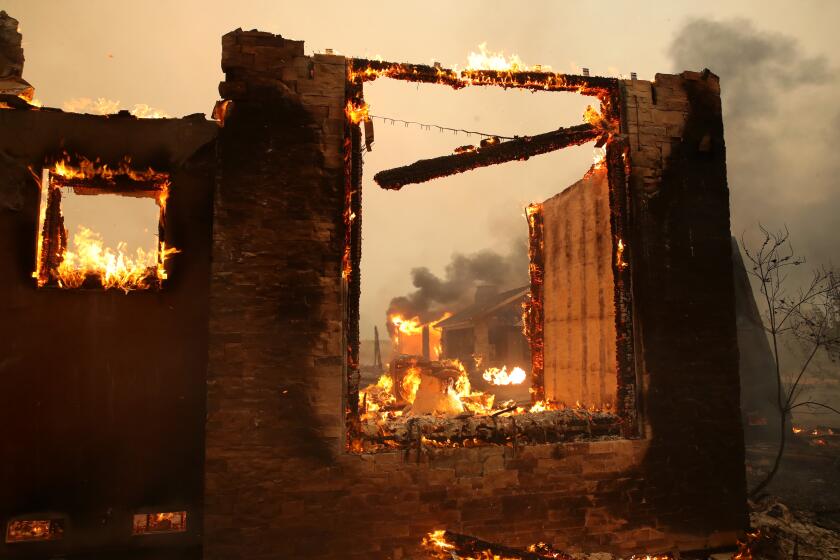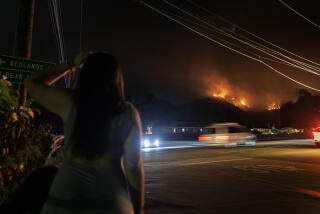More than 90,000 evacuated as Sonoma County fire grows; unprecedented power outages loom

HEALDSBURG, Calif. — Northern California braced for historically powerful winds and widespread power outages as the Kincade fire in Sonoma County raged on, forcing the evacuation of more than 90,000 people.
Pacific Gas & Electric Co. on Saturday began to cut power to 940,000 customers in Northern California to lower the risk of high winds — predicted to gust over 70 mph — knocking down live wires and sparking disastrous fires. More than 2 million people could lose power.
“The next 72 hours is going to be challenging,” Gov. Gavin Newsom told reporters Saturday. “I can sugarcoat it, but I’m not.”
Officials ordered the towns of Healdsburg and Windsor evacuated. At 6 p.m., the order was extended to a wide swath of the Sonoma County coast. The new map shows that other communities under mandatory evacuation include Charles M. Schulz Sonoma County Airport, Guerneville and Bodega Bay, with zones of mandatory evacuation stretching all the way to the Pacific Ocean.
Evacuation warnings were issued to communities in northern Santa Rosa, including the Coffey Park neighborhood that burned in 2017’s Tubbs fire; Sebastopol and surrounding areas; and mountains along the border with Napa County.

Officials emphasized that it was important for the evacuation to be complete before preventive power outages took effect.
By Saturday night, winds are expected to pick up considerably.
“I wouldn’t be surprised if we saw gusts between 80 and 85 mph,” National Weather Service meteorologist Drew Peterson said. “Hopefully, [firefighters] can make some progress. We’ll most likely see the fire spreading once again.”
The California Department of Forestry and Fire Protection warned residents to heed the evacuation orders.
More to know about the Kincade fire
Massive blackouts, historically dangerous winds
Evacuations, shelters, school and road closures in Sonoma County
What to pack if you need to evacuate
How to survive a power outage in your home
Where fires are burning throughout the state right now
Where PG&E may shut off power this weekend
“If we look at the past three years, all of the large and damaging fires have occurred at this time of the year during an offshore wind event, particularly during red-flag warnings,” said Jonathan Cox, a spokesman for Cal Fire. “It has us highly concerned that the vulnerable areas of California could see some explosive fires.”
Officials had already expanded evacuation zones to include Gifford Springs, Whispering Pines, Anderson Springs, Adams Springs, Hobergs and Cobb Mountain.
Authorities said a firefighter and two civilians were injured when they were overwhelmed by flames as the firefighter was attempting to evacuate the pair.
“The firefighter was forced to deploy his fire shelter, where he shielded them from fire,” Cal Fire said in a statement. After the flames passed, all three were taken to a hospital. None of them suffered life-threatening injuries, the statement said.
As of Saturday night, 23,500 structures were threatened. The fire was 11% contained.
Residents of Healdsburg and Windsor and surrounding areas were urged to stay with friends or family outside the evacuation zone. Others were encouraged to head down Highway 101 to Petaluma, where shelters were opening at the veterans hall and the fairgrounds. Livestock could be sheltered at the Santa Rosa fairgrounds, officials said.
Dominic Foppoli, mayor of Windsor, urged residents to move quickly.
“Do not take this warning lightly, we need everybody to evacuate…. This is a life-threatening situation and a danger to our entire town,” he said.
Fire officials said the evacuation orders could be the largest in the region’s history.
“We understand the impact of the evacuations we are about to announce are going to be substantial,” Cox said. “We are really prioritizing safety for what is potentially the worst case scenario.”
The fire, which has burned more than 10,000 acres, torched some structures along Red Winery Road. The total number of structures that have burned was not clear.
By noon in Windsor, traffic was moving slowly south on the 101, a main evacuation route. Lines of cars snaked around a gas station in the town of 28,000.
Paige Sweet, 22, said she quickly packed up her clothes, keepsakes and two German shepherds after hearing the evacuation orders.
Standing in her driveway, Sweet said she never expected to be forced to leave.
“I took things just in case we lose our home,” she said. “It’s definitely nerve-racking if it does come this way. I don’t even know what would happen.”
The National Weather Service said sustained winds from the northeast of 40 mph were expected to push the blaze toward Highway 101. Peak winds, with gusts between 60 mph and 80 mph, were forecast from midnight until sunrise.
Cal Fire said there was high potential for trees and branches to fall across power lines and roads, and for embers to spark new fires.
By 3:30 p.m., Healdsburg was empty. Almost all of its 11,000 residents had heeded the mandatory evacuation that began at 10 a.m., piling into cars that now turned the 101 south toward San Francisco into a bottleneck of traffic.
City Councilman Shaun McCaffery said he was in a hardware store when the word came down that everyone had to go. He had expected the news, but when dozens of cellphones beeped with urgent alerts at the same time, people were alarmed, he said.
With memories of the devastating Tubbs fire just two years ago, most were willing to leave.
“There was consternation earlier today. You are going to get some grumblers,“ said Rhea Borja, spokeswoman for the city of Healdsburg.
But Borja said the city has been working for some time to prepare people for the possibility of a massive departure. Just last weekend, it held a practice drill to get people ready.
Kevin Burke, chief of the Healdsburg Police Department, said his officers had been going door to door all day to confirm that most people were gone. With power scheduled to be cut off within an hour, Burke and his team were patrolling for stragglers.
But not everyone was willing to go.
McCaffery said he was staying. He had been in the hardware store buying sprinklers for his roof, and a 400-pound generator sat in the back of his truck. His family was safe in a hotel in Sebastopol, where the kids were probably in the pool, he said, but he was staying behind in hopes of protecting his home and the family’s three cats — Butter, Percy, and Inka — in case the worst happens and the winds bring embers into the wine country town.
On a side street not far from the town center in Healdsburg, Tom, a resident who declined to give his last name, was in his garage with his son-in-law Kevin drilling holes in particleboard.
“My theory, and I think it’s pretty well proven: I believe all the homes lost in the Tubbs fire were from attic vents,” he said.
A civil engineer, Tom said that he believed sparks flying in the vents had burned the homes from inside. The duo planned on sealing the 35 vents in his home, which is surrounded by a thick shading of trees. Then they would leave town.
“If the police don’t kick me out first,“ Tom said.
A few doors down, Brian White was charging some electric lanterns and listening to the scanner. He said he did not intend to leave his house, which has the double fire buffer of a cemetery behind it and a golf course nearby.
But he sent his two kids and his wife across town to stay with his parents, where they would be easily able to get out of town if need be, and his Suzuki 650 motorcycle was ready in the garage if all hell broke loose.
“It would take a hellacious windstorm” to bring the fire into town, and he didn’t think it would happen, White said. He was more worried about leaving his home unattended in the vacant city.
“It’s a house thing, it’s an ownership thing,” he said.
Further out of town, near the Geyser Peak Winery, Anna Levinger and her crew of farmhands were busy cutting low branches away from anything that could burn and prepping her riding school in case the fire came close. She has 35 horses and a menagerie of other animals including llamas, pigs and goats. She had a “military style“ evacuation plan ready on a spreadsheet.
“Everything I own loads, even my bull,“ she said.
Still, Levinger was not yet planning to leave “because the fire would have to get through miles of vineyards” to reach her. “There are embers and spot fires, but that is not the same as a firestorm, which is what they are selling,” she said. “I think we’ll be fine.“
New mandatory evacuation zones announced Saturday night run right up to the northern edge of Santa Rosa’s city limits, close to the city’s Coffey Park neighborhood, where 1,500 homes were destroyed in the Tubbs fire in 2017.
Sections of northern Santa Rosa were under evacuation warning, including the private Fountaingrove Club, which is home to a golf course and athletic facilities, as well as neighborhoods along Fountaingrove Parkway and Parker Hill Road.
Stephen Volmer, a Cal fire analyst, said the new evacuations were caused when the fire shot out into an area on its eastern flank. Volmer said that area could blow embers into the nearby Alexander Valley.
If the valley caught fire, sparks could then reach Healdsburg, potentially blowing up to a mile at a time all the way to the Pacific.
The evacuation orders also include the Sonoma County Jail, officials said. The facility’s 350 inmates are currently being evacuated to the Santa Rita Jail.
Fire officials said the greatest danger will come if the fire jumps the 101 as it did in 2017 in some spots. Volmer said this is a special concern around Healdsburg, where there has not been a significant fire incident since the 1940s, leaving heavy brush in the area.
Sonoma County Sheriff Mark Essick said one wireless alert was sent out to the new evacuation zones before power was cut off.
But county Supervisor Lynda Hopkins said many of the areas being evacuated are subdivisions that “should never have been built“ on steep hillsides with few roads in or out. She said she is especially concerned about Guerneville, where many people do not have cars and there is a large population of senior citizens — and only two roads in and out.
“It’s scary,” she said.
Weather forecasters said the Diablo winds were expected to begin in earnest about 8 p.m., blowing embers of the Kincade fire perhaps for miles. When the 4 p.m. bells rang at the local church, there was a little more than a breeze rustling the oaks and evergreens in the town square.
The Kincade fire began Wednesday night and has swept through an area where memories of the Tubbs fire that burned entire neighborhoods to the ground two years ago are still vivid. That 2017 fire scorched more than 36,000 acres and claimed 22 lives.
This time around, the community has had more time to prepare, said Sonoma County Supervisor James Gore.
“We are in a position where we are reliving something, but we’re ahead of it,” Gore said. “It’s going to test to our resolve. Everybody in our community needs to get the heck out of the way of the first responders so they can do their job.”
On Saturday afternoon, the governor traveled to a mobile home park in American Canyon and spoke with residents who said they were warned about the power outage just a few hours before PG&E planned to cut the lights.
Lucille Constantine, who has chronic obstructive pulmonary disease, told the governor that she tried to pick up extra medication from a nearby pharmacy before the store lost power. But her health insurance under Medicare wouldn’t pay for the additional treatments until her existing supply ran out, she said.
Constantine, 69, said she was told she could pay over $1,000 out of pocket for the medication and seek reimbursement later.
“You could get it if you have the money,” Constantine said. “But I can’t afford that right now. It’s a month’s rent.”
Another resident of Las Casitas mobile home park, Tom Mogg, showed Newsom a generator he purchased for $800 over the summer.
Mogg, 93, said that he can’t afford for the food in his two refrigerators and freezer to spoil during an outage and that his partner, Lillian Crimmins, needs the generator to power a machine that helps her breathe at night.
“We figured if I have trouble, we’ve got a way to get it plugged in with the generator,” said Crimmins, 87.
Mogg blasted PG&E.
“For too many years, instead of fixing the infrastructure, hardening the lines and doing all the things they should have been doing to make this a first-class electrical system, they’ve been pouring it into executive salaries, stockholders,” Mogg said. “They are not pouring it into the areas that are going to affect them delivering energy to us.”
On Friday, the governor said the state had secured $75 million for areas affected by power shut-offs, including in Southern California, where the Tick fire has been burning. Half would be allocated to local governments, with the cities of Los Angeles, San Jose, San Diego and Oakland receiving $500,000 each. The money could be used to purchase equipment to mitigate the effects of shut-offs, such as generators, fuel storage and other backup energy sources.
This week, the state provided additional resources to assist PG&E in inspecting power lines and turning the power back on more quickly, including for aircraft and infrared technology, Newsom said.
More to Read
Sign up for Essential California
The most important California stories and recommendations in your inbox every morning.
You may occasionally receive promotional content from the Los Angeles Times.
















